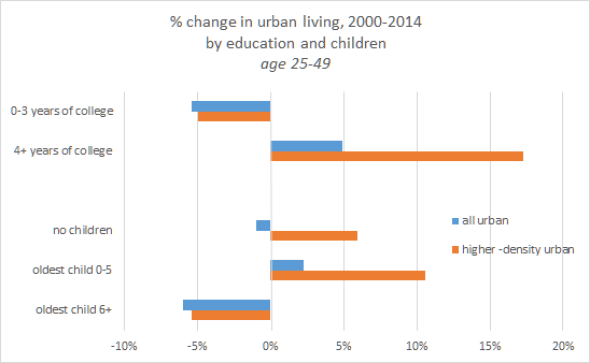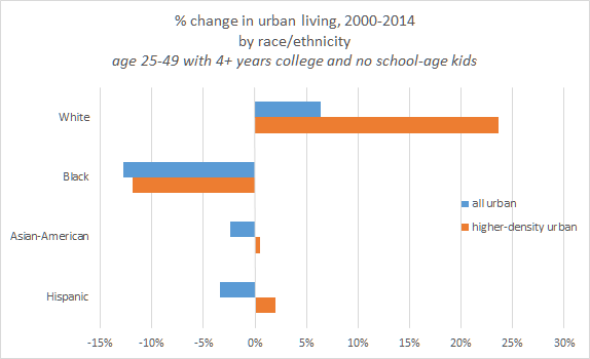Jed Kolko, the former chief economist at Trulia, has been working double time to puncture the idea that the United States is in the midst of a great shift toward urban living. Instead of looking at the movement of Americans to and from cities or metro areas, he’s had the great insight to analyze the growth of different neighborhoods by housing density—the logic being that some cities full of detached single-family homes, like Charlotte, North Carolina, actually look an awful lot like suburbs, and some suburbs full of row houses and apartments, like Hoboken, New Jersey, look and feel a lot like cities. His work has shown that after briefly falling behind following the recession, sprawling ‘burbs are once again growing faster than jam-packed urban neighborhoods. Young adults, often stereotyped as bike-riding, coffee-shop-dwelling city creatures, are actually becoming less urban overall.
That said, the masses of affluent families toting strollers through Brooklyn and San Francisco aren’t a figment of our national imagination. As Kolko details Wednesday, certain demographic groups really are experiencing an urban revival while others retreat to suburbs. The white, the wealthy, the college-educated, and the parent-aged have moved into the densest cities, while the poor and black are moving away. Gentrification isn’t a joke.
The following series of graphs, which Kolko kindly allowed me to post, spells out the story. The highest-earning 40 percent of U.S. households are all more likely now than they were in 2000 to live in the densest urban neighborhoods, a category that encompasses most parts of cities like New York, Chicago, Boston, Philadelphia, and Washington, D.C., plus some thoroughly built-up suburbs like Arlington, Virginia. But the change has been most dramatic at the top of the income ladder: The richest tenth of Americans are now 12 percent more likely to live in a superurban area. Meanwhile, the poorest 12 percent are 17 percent less likely to.

Older millennials are, indeed, more likely to live downtown than young adults were a decade-and-a-half ago. But among all age groups, the biggest shift toward high-density urban living has been among 35-to-39-year-olds—the younger slice of Gen X.

Among those age brackets, though, only the college-educated are returning to the city on net. And while parents with young children are moving to denser, urban areas, those with older kids have shifted to the suburbs, suggesting schools are still driving families into the ’burbs.

Finally, while whites really are becoming far more urban, black households are becoming far less so.

The return of affluent, educated whites to the urban core obviously has lots of economic and political upsides for major cities (it brings in tax dollars and spending; state and national politicians are a lot less likely to ignore the desires of the upper-middle class than the poor; etc.). But it’s not clear anybody has a good answer for what to do about the low-income families that are being pushed to the metro periphery, further from jobs and the social services geared toward supporting them. Given that longer commutes are associated with lower levels of income mobility, it’s possible that the changing faces of our cities are going to make it harder for the poor to escape poverty.
America’s biggest cities might not quite be citadels of privilege, but they’ve moved further in that direction. Urban decay created one set of problems. Urban revival will create its own.
